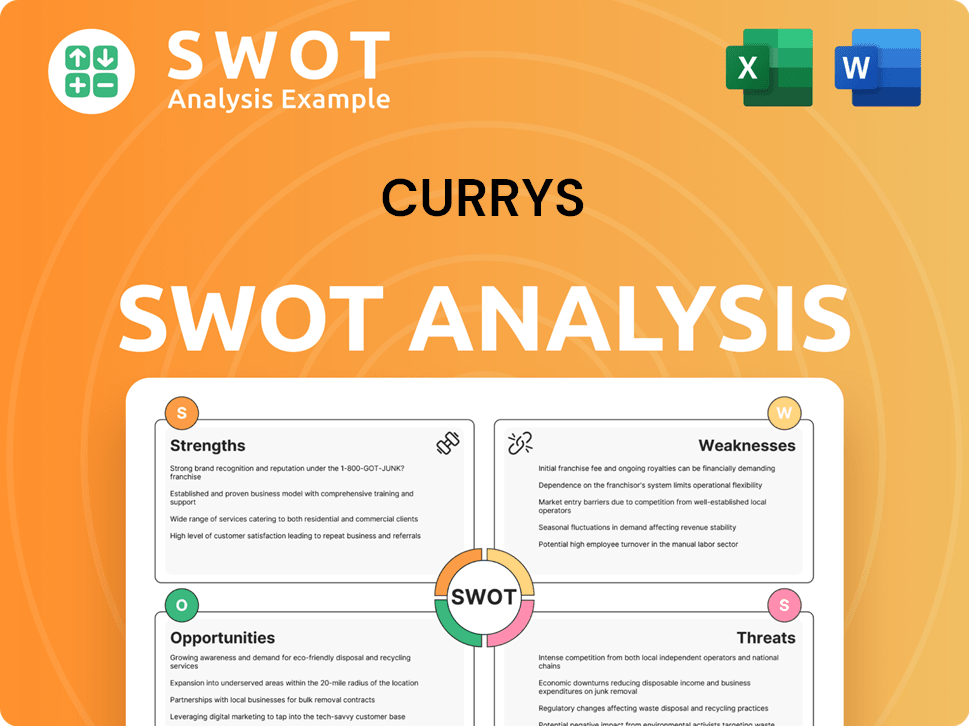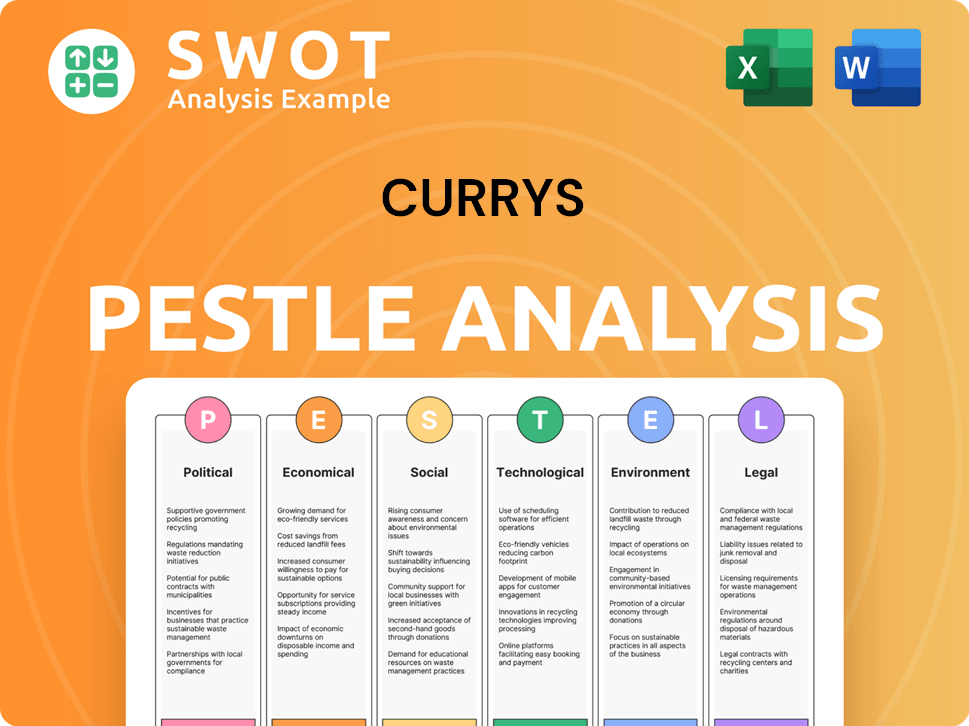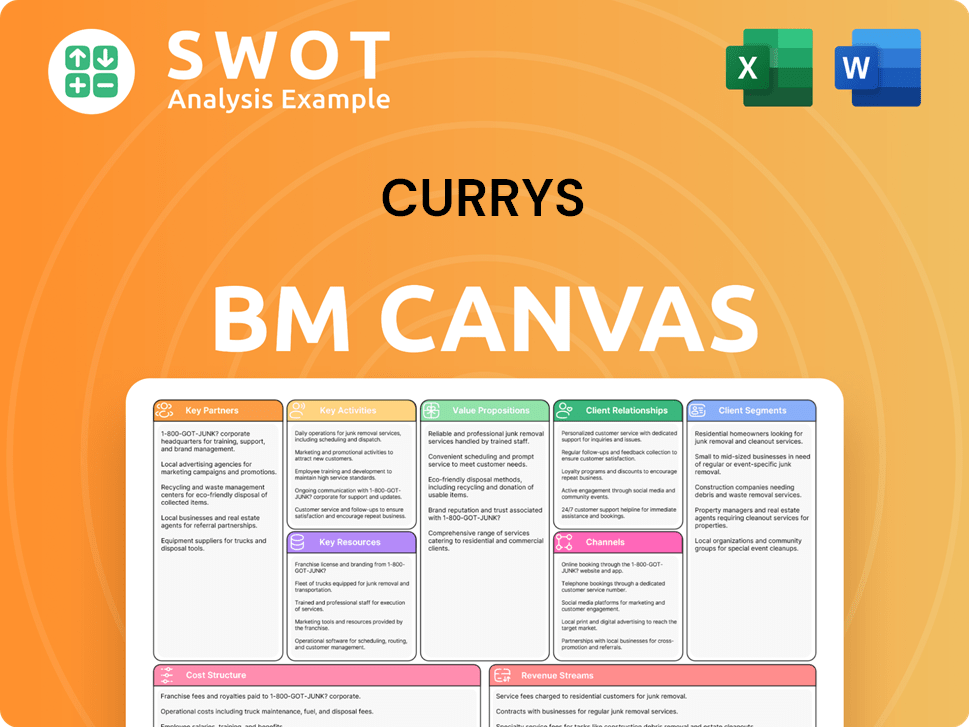Currys Bundle
Who Really Owns Currys?
Unraveling the complex ownership structure of Currys is key to understanding its future. The company, a major player in the tech retail sector, has seen significant shifts, notably the 2024 takeover interest from Elliott Advisors and JD.com. This highlights the critical role of ownership in shaping Currys' strategic direction and market strategies. Currys SWOT Analysis can help you understand the company's position.

Understanding 'Who owns Currys' provides crucial insights into its operations and strategic decisions. Currys plc, formerly known as Dixons Carphone, has a rich history dating back to 1884, evolving into a dominant force across the UK, Ireland, and the Nordics. This exploration will delve into the Currys company ownership, examining its evolution, key stakeholders, and the influence of its board of directors to understand its resilience and innovation in a dynamic market. The Currys PC World brand is also part of the company.
Who Founded Currys?
The origins of Currys plc, a major player in the UK's electrical retail sector, can be traced back to 1884. Henry Curry founded a bicycle-making business in Leicester, UK, marking the initial venture that would evolve into the modern retail giant. While specific details on the exact equity split or initial shareholding percentages from this early period are not readily available, the company's ownership was primarily within the Curry family.
As the business expanded, it broadened its offerings beyond bicycles. The company started including radios, gramophones, and a wide array of electrical goods. This shift demonstrated a vision to adapt to the changing technological demands of consumers. This early strategy set the stage for its future growth and diversification.
The transition from a family-owned enterprise to a more structured business involved formalizing operations. Early agreements, though not publicly detailed, would have governed the operational control and financial interests within the family. The early vision of the founding team was to establish a retail presence that could adapt to the rapid advancements in consumer technology, a principle that has guided Currys through its various transformations. Any initial ownership disputes or buyouts from this distant past are not widely documented in public records, but the gradual expansion and eventual public listing suggest a structured evolution of ownership from its foundational roots.
The early ownership of Currys, initially a bicycle business, was centered on the Curry family. The company's evolution involved a shift from family ownership to a more formalized structure, reflecting its growth and diversification. The company's expansion into electrical goods and its adaptation to technological advancements highlight its strategic vision. For more detailed insights, you can refer to the article on the Currys company history.
- Henry Curry founded the company in 1884.
- The business originally focused on bicycles.
- Expansion included radios, gramophones, and electrical goods.
- Early ownership was primarily within the Curry family.
Currys SWOT Analysis
- Complete SWOT Breakdown
- Fully Customizable
- Editable in Excel & Word
- Professional Formatting
- Investor-Ready Format

How Has Currys’s Ownership Changed Over Time?
The ownership of Currys plc, formerly known as Dixons Carphone, has evolved significantly since its inception. The transition to a publicly traded company was a pivotal moment, broadening its ownership base to include both institutional and individual investors. The company's presence on the London Stock Exchange, under various names, highlights its long-standing position in the market, with the 2021 rebranding to Currys plc aiming to solidify its brand identity and market presence.
The evolution of Currys' ownership reflects strategic shifts and market dynamics. The company's history includes name changes, acquisitions, and responses to market challenges, all of which have influenced its shareholder structure. The interest from entities like Elliott Advisors and JD.com in acquiring Currys underscores the company's perceived value and the potential for future ownership changes. Understanding the ownership structure is crucial for grasping the company's strategic direction and financial health, as explored further in the analysis of Currys' business model.
| Key Event | Impact on Ownership | Year |
|---|---|---|
| Initial Public Offering (IPO) | Transition to public ownership, broadening shareholder base. | Not readily available, but historically significant. |
| Acquisition of Carphone Warehouse (Dixons Carphone) | Merger creating a larger entity, impacting ownership structure. | 2014 |
| Rebranding to Currys plc | Consolidation of brand identity, potentially influencing investor perception. | 2021 |
| Takeover Bids (Elliott Advisors, JD.com) | Potential shift in ownership, reflecting market valuation and strategic interest. | Early 2024 |
As of early 2025, the major stakeholders in Currys plc are primarily institutional investors. These include asset management firms, mutual funds, and index funds that hold substantial portions of the company's shares. For example, in February 2024, major shareholders included BlackRock, Vanguard, and Capital Group. These institutional investors wield significant influence over the company's strategic decisions and governance. The company's market capitalization, a key factor in takeover bids, fluctuates based on market conditions and performance. The interest from external entities highlights the dynamic nature of ownership in publicly listed companies.
Currys' ownership structure is primarily influenced by institutional investors. These large shareholders shape strategic decisions and governance. The company's market capitalization reflects its performance and is a key factor in potential acquisitions.
- Institutional investors hold a significant portion of shares.
- Market capitalization fluctuates based on performance.
- Takeover bids highlight the dynamic nature of ownership.
- Rebranding and acquisitions have shaped the ownership.
Currys PESTLE Analysis
- Covers All 6 PESTLE Categories
- No Research Needed – Save Hours of Work
- Built by Experts, Trusted by Consultants
- Instant Download, Ready to Use
- 100% Editable, Fully Customizable

Who Sits on Currys’s Board?
The current board of directors of Currys plc, also known as Currys PC World, plays a vital role in the company's governance and strategic oversight. As of early 2025, the board typically includes executive directors, non-executive directors, and independent non-executive directors. Alex Baldock serves as the Group Chief Executive, providing executive leadership. Ian Dyson is the Chairman, overseeing the board's function and strategic direction. Other board members include independent non-executive directors, who bring external expertise and provide independent oversight. The board's composition reflects the company's commitment to sound governance and shareholder value.
The board's structure is designed to represent the interests of a diverse shareholder base. The board members bring a variety of skills and experiences to the table, ensuring a well-rounded approach to decision-making. The board's responsibilities include setting the company's strategic direction, overseeing financial performance, and ensuring compliance with regulations. The board's decisions are crucial for the long-term success of Currys, including its financial performance and market position. The board's composition and activities are regularly reviewed to ensure effectiveness and alignment with best practices in corporate governance.
| Board Member | Role | Notes |
|---|---|---|
| Alex Baldock | Group Chief Executive | Provides executive leadership |
| Ian Dyson | Chairman | Oversees the board's function and strategic direction |
| Independent Non-Executive Directors | Various | Bring external expertise and provide independent oversight |
Currys operates under a one-share-one-vote structure, which is standard for publicly listed companies on the London Stock Exchange. This means that each ordinary share carries one vote, ensuring that voting power is directly proportional to the number of shares held. There is no public indication of dual-class shares or special voting rights that would grant outsized control to specific individuals or entities. This structure promotes equitable representation based on share ownership. Major institutional shareholders exert influence through their substantial holdings, but the governance structure is designed to promote fairness. The board's decisions are crucial for the long-term success of Currys, including its financial performance and market position. For further insights into the strategic direction of the company, consider reading about the Growth Strategy of Currys.
Currys' governance structure ensures that voting power is directly proportional to share ownership, with each share carrying one vote. This structure promotes fairness and equitable representation among shareholders. The board's decisions are critical for the company's success.
- One-share-one-vote structure
- No dual-class shares
- Equitable representation based on share ownership
- Board oversight of strategic direction
Currys Business Model Canvas
- Complete 9-Block Business Model Canvas
- Effortlessly Communicate Your Business Strategy
- Investor-Ready BMC Format
- 100% Editable and Customizable
- Clear and Structured Layout

What Recent Changes Have Shaped Currys’s Ownership Landscape?
Over the past few years, the ownership of Currys plc, formerly known as Dixons Carphone, has seen significant developments. In early 2024, there were notable takeover bids. Elliott Advisors made an offer valuing Currys at approximately £700 million, or 62 pence per share, which was rejected by the board. Additionally, JD.com showed interest but ultimately decided not to proceed with a bid. These events highlight the company's strategic importance and potential for value creation.
These developments are intertwined with broader industry trends. The retail technology sector is experiencing increased institutional ownership. Currys has been focused on improving profitability and optimizing operations, which directly affects shareholder value. The company's leadership has emphasized maximizing shareholder value, a key consideration during recent takeover approaches. The company's future ownership may be affected by market consolidation, further strategic investments, or renewed interest from potential buyers. Considering the Competitors Landscape of Currys, it's clear that market dynamics are crucial.
The ownership structure of Currys is currently influenced by these market factors. The company's focus on shareholder value and strategic moves suggests that its ownership profile may continue to evolve. The company's response to takeover bids and its efforts to optimize operations reflect its commitment to enhancing shareholder returns and navigating the competitive landscape.
Unsolicited takeover bids in early 2024 from Elliott Advisors and JD.com. Elliott Advisors offered £700 million. JD.com considered a bid but did not proceed.
Increased institutional ownership in publicly traded companies. Focus on operational optimization and profitability. Emphasis on maximizing shareholder value.
Enhancing shareholder value is a priority. The company aims to navigate market competition. Future ownership may be influenced by consolidation.
The company's response to bids reflects its commitment. Market factors will continue to shape ownership. The company's future is subject to change.
Currys Porter's Five Forces Analysis
- Covers All 5 Competitive Forces in Detail
- Structured for Consultants, Students, and Founders
- 100% Editable in Microsoft Word & Excel
- Instant Digital Download – Use Immediately
- Compatible with Mac & PC – Fully Unlocked

Related Blogs
- What are Mission Vision & Core Values of Currys Company?
- What is Competitive Landscape of Currys Company?
- What is Growth Strategy and Future Prospects of Currys Company?
- How Does Currys Company Work?
- What is Sales and Marketing Strategy of Currys Company?
- What is Brief History of Currys Company?
- What is Customer Demographics and Target Market of Currys Company?
Disclaimer
All information, articles, and product details provided on this website are for general informational and educational purposes only. We do not claim any ownership over, nor do we intend to infringe upon, any trademarks, copyrights, logos, brand names, or other intellectual property mentioned or depicted on this site. Such intellectual property remains the property of its respective owners, and any references here are made solely for identification or informational purposes, without implying any affiliation, endorsement, or partnership.
We make no representations or warranties, express or implied, regarding the accuracy, completeness, or suitability of any content or products presented. Nothing on this website should be construed as legal, tax, investment, financial, medical, or other professional advice. In addition, no part of this site—including articles or product references—constitutes a solicitation, recommendation, endorsement, advertisement, or offer to buy or sell any securities, franchises, or other financial instruments, particularly in jurisdictions where such activity would be unlawful.
All content is of a general nature and may not address the specific circumstances of any individual or entity. It is not a substitute for professional advice or services. Any actions you take based on the information provided here are strictly at your own risk. You accept full responsibility for any decisions or outcomes arising from your use of this website and agree to release us from any liability in connection with your use of, or reliance upon, the content or products found herein.